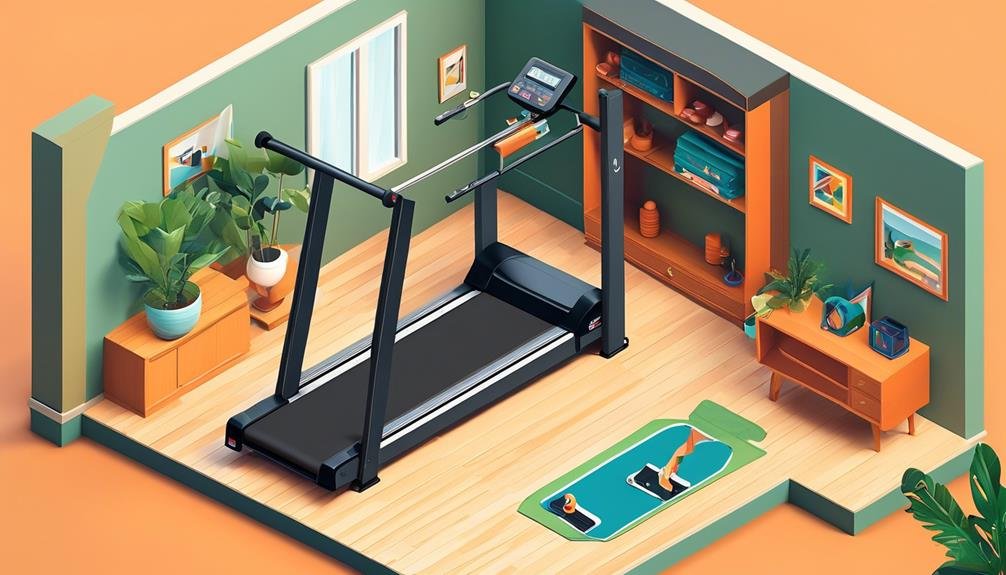Have you ever wondered if there's a proper way to break in a new treadmill at home? You might have heard some theories or advice, but how do you know what really works?
Well, in this discussion, we're going to uncover the truth and provide you with the essential steps to ensure you properly break in your new treadmill.
So, if you want to make the most out of your investment and ensure the longevity of your machine, keep on reading to discover the secrets of proper treadmill break-in.
Key Takeaways
- Thoroughly read the instruction manual for proper assembly and calibration instructions
- Gradually increase the workout intensity to avoid pushing yourself too hard during the break-in period
- Monitor and adjust your running technique to reduce the risk of injury and maximize effectiveness
- Regularly maintain the treadmill belt and deck, clean the surface areas, and check for any signs of damage or wear
Setting Up Your Treadmill
To properly set up your new treadmill at home, it's essential to thoroughly read the instruction manual and gather the necessary tools for a smooth and hassle-free assembly process. The manual will provide you with step-by-step instructions on how to assemble the treadmill correctly, ensuring that all parts are in place and secure. Make sure to take your time and follow the instructions carefully, as rushing through the setup process may result in mistakes or complications down the line.
It is also recommended to have another person assist you during the assembly. Some treadmill parts can be heavy and require careful handling. Having someone help you won't only make the process easier but also ensure your safety.
When choosing a location for your treadmill, make sure to find a level surface with sufficient space around it. This will help prevent any accidents and provide you with a comfortable workout experience.
Before plugging in your treadmill, check that the electrical outlet is properly grounded and that there are no loose or damaged wires. This simple precaution can prevent any electrical issues and ensure the safe operation of your treadmill.
Properly Calibrating the Machine
To ensure accurate readings and optimal performance of your treadmill, it's essential to properly calibrate the machine according to the manufacturer's instructions. Calibrating the machine involves adjusting its settings to ensure they align with the actual speed and incline of the treadmill. This step is crucial, especially when you're trying to break in a new treadmill at home.
The first thing you should do is consult the manufacturer's manual for specific instructions on how to calibrate your treadmill. Different models may have different calibration processes, so it's important to follow the guidelines provided. Once you have the instructions, make sure to read them thoroughly before starting the calibration process.
Most treadmills come with built-in calibration features that allow you to adjust the speed and incline settings. Follow the steps outlined in the manual to access these features and make the necessary adjustments. During the calibration process, pay close attention to the treadmill's performance. Monitor the speed and incline readings to ensure they're accurate and consistent.
It is recommended to calibrate the machine regularly, especially after any transport or relocation. This will help maintain the accuracy of the treadmill's readings and ensure optimal performance. If you encounter any difficulties or notice discrepancies during the calibration process, it's best to seek professional assistance. They'll have the expertise to address any issues and ensure your treadmill is properly calibrated.
Gradually Increasing Your Workout Intensity

Now that you have properly calibrated your treadmill, it's time to take your workout to the next level by gradually increasing your workout intensity. This step is crucial in the break-in process of your new treadmill and will help you get the most out of your workouts.
To begin, start with a comfortable pace and incline to warm up your muscles. This will prepare your body for the more challenging workout ahead. As you continue, gradually increase the speed or incline slightly every few minutes to challenge yourself. Pay attention to your body's response and adjust the intensity accordingly. If you feel that the workout is too easy, increase the speed or incline a little more. On the other hand, if you find it too difficult, decrease the intensity to a level that's comfortable for you.
It's important to listen to your body and avoid pushing yourself too hard, especially during the break-in period. Gradually build up to a more challenging workout over several sessions. This will allow your body to adapt and prevent any unnecessary strain or injuries.
Monitoring and Adjusting Your Running Technique
You can enhance your treadmill workout by monitoring and making necessary adjustments to your running technique. By paying attention to your form and making corrections as needed, you can reduce the risk of injury and maximize the effectiveness of your workout.
Here are a few key areas to focus on:
- Posture: Maintain an upright posture with your shoulders relaxed and your gaze forward. Avoid leaning too far forward or backward, as this can strain your back and affect your balance.
- Foot Placement: Land each step in the middle of the belt, ensuring that your feet are aligned with your hips. This will help you maintain stability and prevent unnecessary stress on your joints.
- Stride Length: Find a stride length that feels comfortable and natural for you. Avoid overstriding, as this can lead to inefficient movement and increase the wear on the treadmill belt.
Maintaining the Treadmill Belt and Deck

Maintain the longevity and performance of your treadmill by properly maintaining the belt and deck. Taking care of the treadmill belt and deck is essential to ensure smooth and safe workouts. After each use, be sure to wipe down the surface areas with a wet cloth or sanitizing wipe. This will help remove any sweat or dirt that may have accumulated during your workout.
Additionally, it's important to lubricate the deck every 150 miles to prevent belt wear. Lubricating the deck reduces friction between the belt and the deck, allowing for a smoother and quieter operation.
Using a mat underneath your treadmill is another way to maintain the treadmill belt and deck. Not only does it protect your floor from any potential damage, but it also helps reduce noise. The mat absorbs the impact of your footsteps, reducing the strain on the treadmill's components.
Regularly checking the tension of the belt is also crucial. A loose belt can cause slipping and instability while a tight belt can put unnecessary strain on the motor. If you notice any signs of a loose belt, tighten it using the adjustment screws provided.
Regular Cleaning and Maintenance
After properly maintaining the belt and deck of your treadmill, it's important to shift your focus to regular cleaning and maintenance to ensure optimal performance and longevity. Regular cleaning not only keeps your treadmill looking clean and hygienic, but it also helps prevent corrosion, kills germs, and ensures a longer lifespan for your equipment. Here are some important steps to follow for regular cleaning and maintenance:
| Cleaning Tips | Maintenance Tips |
|---|---|
| Wipe down the surface areas with a wet cloth or sanitizing wipe after each use to prevent dirt and debris accumulation. | Inspect the belt regularly for any signs of wear or damage. If the belt needs to be replaced, consult the manufacturer's instructions. |
| Clean underneath the treadmill with a vacuum to remove hidden dirt and maintain proper functionality. | Lubricate the belt every three months or as recommended by the manufacturer to reduce friction and ensure smooth operation. |
| Use a mild detergent or cleaning solution for tougher stains and to ensure a hygienic exercise environment. | Check the tension of the belt and make necessary adjustments to ensure it is properly aligned and tight. |
| Vacuum the area under and around the treadmill weekly to prevent dust buildup and maintain cleanliness. | Regularly check the power cord for any signs of damage and replace if necessary. |
Troubleshooting Common Issues

To troubleshoot common issues with your new treadmill, start by checking the tension of the belt and ensuring it's properly aligned. A loose or misaligned belt can lead to slipping and uneven wear, which can affect the performance and longevity of your treadmill. Use the tension adjustment knob or bolt to tighten the belt if necessary, making sure it's snug but not too tight.
Next, inspect the rollers for any debris or signs of wear. Clean them with a damp cloth and tighten any loose screws or bolts to ensure smooth operation. Rollers are an important part of your treadmill's mechanism, as they help move the belt smoothly.
Regularly cleaning the air vents is also vital for troubleshooting common issues. Over time, dust and dirt can accumulate, causing the motor to overheat. This can lead to performance problems or even damage the motor. Clean the vents with a soft brush or cloth to ensure proper airflow and prevent overheating.
Always check the power cords for any damage, such as fraying or exposed wires. If you notice any issues, replace the cords immediately to prevent electrical problems.
Lastly, schedule regular professional maintenance and servicing for your treadmill. This will help address any potential issues before they become major problems and will keep your treadmill in optimal condition.
Frequently Asked Questions
Do New Treadmills Need to Be Broken In?
Yes, new treadmills need to be broken in. This is because they may have initial issues like a stiff belt and dashboard problems. Breaking it in properly ensures a smoother and more comfortable running experience.
Do Treadmills Have a Break in Period?
Treadmills do have a break-in period. Start by using it for short intervals at a lower speed. Gradually increase time and speed over a few weeks. This helps the motor and belt adjust properly.
Do Home Treadmills Break Easily?
Home treadmills can break easily if not properly maintained. Regular maintenance and care are necessary to prevent breakdowns and extend their lifespan. Follow the manufacturer's guidelines and perform routine checks to avoid potential issues.
How Do I Know if My Treadmill Needs Lubricant?
To know if your treadmill needs lubricant, watch for jerking or sticking of the belt, listen for squeaking or grinding sounds, check the owner's manual for recommended maintenance, and inspect the belt and deck for wear.
Conclusion
Congratulations on your new treadmill!
By following these steps, you'll ensure that your treadmill stays in top shape and provides you with an optimal workout experience.
Remember to clean and maintain it regularly, lubricate the deck, and protect it from power surges.
With proper care, your treadmill will be the perfect addition to your home gym and help you achieve your fitness goals.
Happy running!





